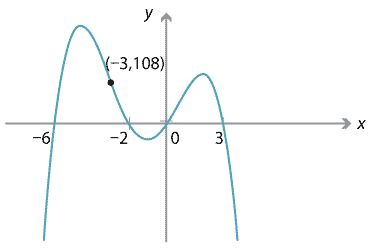Content
Polynomials from graphs
Given a polynomial, we have seen how to draw its graph. Now we do the reverse: given a graph, find the polynomial.
It is useful to remember that it takes two points to define a line, and three points to define a parabola. In general, it takes \(n+1\) points to define a polynomial of degree \(n\). This is not surprising, since a polynomial of degree \(n\) has \(n+1\) coefficients.
Example
The graph \(y=f(x)\) of the quartic polynomial \(f(x)\) is drawn below. Find \(f(x)\).

Detailed description of diagram
(Reality check: Five points are specified in the graph, namely four \(x\)-intercepts and one extra point. This is the right number of points to determine a quartic polynomial.)
Solution
The graph shows four \(x\)-intercepts at \(x=-6,-2,0,3\). Hence \((x+6)\), \((x+2)\), \(x\) and \((x-3)\) are all factors of \(f(x)\). Multiplying these factors together already gives a quartic; the only other possible factor is just a constant. So \(f(x) = c(x+6)(x+2)x(x-3)\) for some constant \(c\). Since \(f(-3)=108\), we have \(108 = c \cdot 3 \cdot (-1) \cdot (-3) \cdot (-6)\), so \(108 = -54c\) and \(c=-2\). Thus \(f(x) = -2(x+6)(x+2)x(x-3)\).
The above example demonstrates that knowing the roots is not enough information to determine a polynomial. Indeed, in the example, there is a whole family of polynomials \(f(x) = c(x+6)(x+2)x(x-3)\) with the same roots, where \(c\) is any (non-zero) real number. We needed the extra data of a point on the curve to determine \(c\).
In general:
- An \(x\)-intercept at \(x=a\) implies that \((x-a)\) is a factor of \(f(x)\).
- A \(y\)-intercept at \(y=c\) implies that \(f(0)=c\), i.e., the constant term in \(f(x)\) is \(c\).
- A given point \((p,q)\) on the graph implies that \(f(p)=q\).
If we are just given points on the graph of \(y=f(x)\), one way to find the polynomial is by simultaneous equations, as the following example shows.
Example
Find the quadratic polynomial \(f(x)\) whose graph passes through the three points \((1,-2)\), \((2,-1)\) and \((3,2)\).
Solution
Let the polynomial be \(f(x) = ax^2 + bx + c\). We are given that \(f(1)=-2\), \(f(2)=-1\) and \(f(3)=2\), so we have the simultaneous equations
\begin{alignat*}{2} a+b+c &= -2 &\qquad\qquad& (1) \\ 4a+2b+c &= -1 && (2) \\ 9a+3b+c &= 2. && (3) \end{alignat*}Subtracting \((2)-(1)\) and \((3)-(2)\) gives \(3a+b = 1\) and \(5a+b=3\). Subtracting these two equations gives \(2a=2\), so \(a=1\). Substituting \(a=1\) back into these equations gives \(b=-2\) and then \(c=-1\). So \(f(x) = x^2 - 2x - 1\).
In principle we could use the above method to find, say, a quintic through six given points, or a degree-100 polynomial through 101 given points; it just becomes increasingly tedious to eliminate the variables and solve the simultaneous equations!
As it turns out (and beyond the secondary school curriculum), there is actually a formula for the polynomial through a given set of points, called the Lagrange interpolation formula, discussed in the Appendix section.
